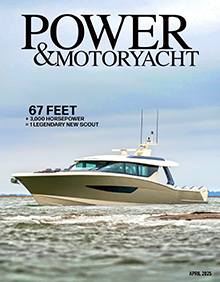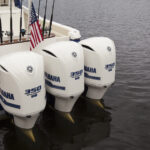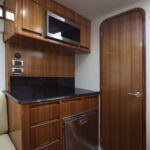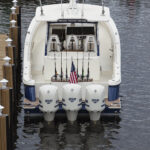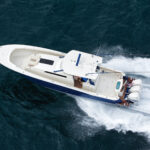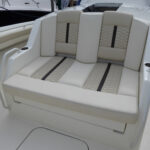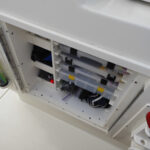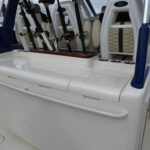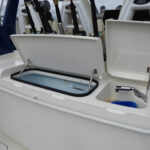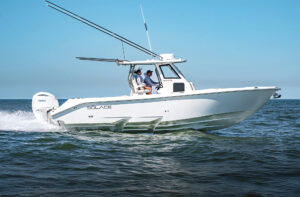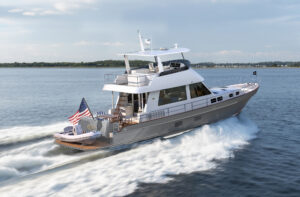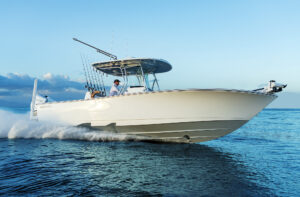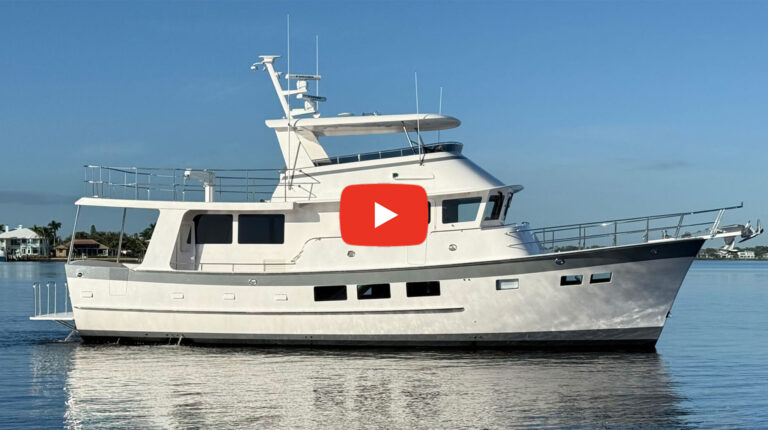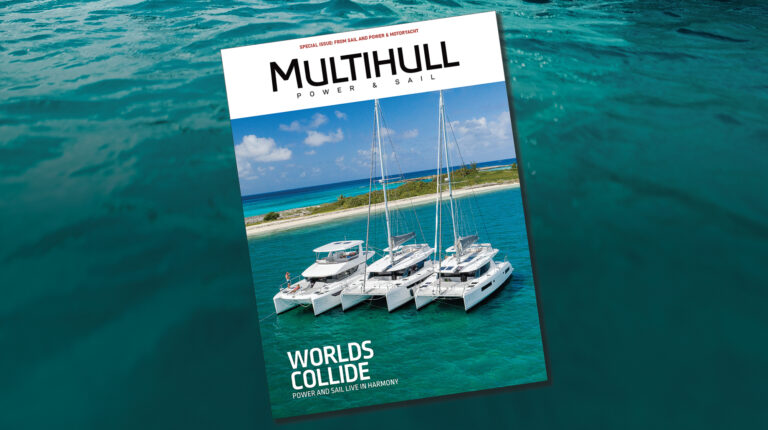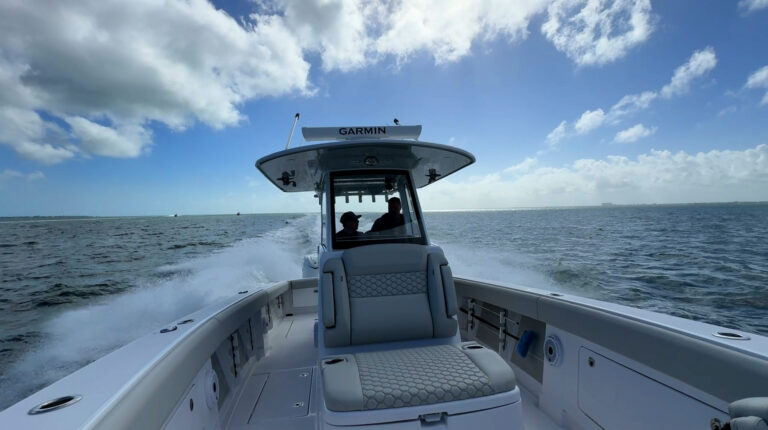Thrill Ride
The custom-built 41.5 center console from Sea Force IX is a hard-charging sport yacht hell-bent on bluewater.

There’s no shortage of big outboard-powered center consoles charging around the ocean these days, both as fishing boats and megayacht tenders. But in this sea of familiarity, the 41.5 by Sea Force IX drums the water to a different beat.
What makes this boat so different? The philosophy of the manufacturer based in Palmetto, Florida, for starters. The typical drill for a center console builder is to begin with a small boat and eventually go larger as experience grows. Sea Force, however, works in the opposite direction. At 41 feet, the 41.5 is a scaled-down version of its larger boats.
Sea Force has been making custom sportfishing convertible yachts from 70 to 94 feet since 2001; another division builds steel and aluminum yachts and patrol boats. The company runs a full-service yard, too. This soup-to-nuts operation is headed by Capt. Ron Rookstool, whose “been there, done that” reputation is based on his life’s work creating premium vessels, one boat at a time.
I stepped aboard the 41.5 at the Buccaneer Yacht Club in Palm Beach Shores, Florida. The plan was to go offshore for a day of sailfishing; we’d troll lines just south of Lake Worth Inlet in about 120 feet of water. The boat’s custom-yacht pedigree was immediately evident. Fit and finish were exemplary and the hull gleamed under its Awlgrip/Awlcraft top coat.
You won’t see any print-through on this boat, even with the dark blue hull, because parts are baked after lay-up to eliminate any possibility of post-cure anomalies. Built on a jig, composite construction includes hand-laid multidirectional knitted laminates that are vacuum-bagged to DIAB structural foam. The hull, deck and liner are fusion-bonded to the stringer grid and the bulkheads, then glassed in place with West epoxy. The result is what Sea Force calls its monolithic construction, a process also used on the company’s larger yachts. It makes for a hefty boat that’s more than ready for blue water, particularly with its deep-V hull (23 degrees of transom deadrise).
The 41.5 is the first in a new series of performance sport yacht center consoles that will extend to 55 feet. “It’s for experienced yachtsmen who want the same features, comfort and quality they enjoy aboard their larger vessels,” said Todd Albrecht, the company’s sales and marketing director. He was on board for the sea trial.
Our test boat was set up for fishing and the cockpit was all business with a 37-inch reach to the waterline and an average depth of 28 inches. It was outfitted with 20 rod holders: six in the slender fiberglass coaming that was lined with a plush bolster, seven at the transom rocket launcher and another seven in the rocket launcher at the bait station near the helm. The vacuumed-bagged fiberglass hardtop features a cutout for the rods at the bait station. I prefer this setup to rods mounted on the hardtop, as it makes it easier for crew to grab the gear when they’re working in the cockpit. The two rocket launchers are teak and coated with West epoxy resin and Awlgrip Clear, which says a lot about the way this company treats each boat it builds.
At the transom, our goggle-eyes swam freely in an LED-illuminated 55-gallon livewell. Fittings near the top of the livewell accommodate stanchions for a removable seat with backrest. The owner can install that when he wants to shift gears and enjoy a crowd-pleasing cruising vessel. Transom doors flank the livewell and provide access to the teak-planked swim platform with boarding ladders and big 12-inch, pull-up cleats.

Triple Llebroc seats face a clean and modern helm station with well-done custom details, including the teak pod and Edson wheel.

The bait station includes a cutting board, freshwater sink and an insulated bin that holds 180 pounds of ice provided by the 540-pound-per-day chipper. Tackle and loose gear stow in compartments on either side of the bait station. I like this arrangement more than aft-facing drawers, which can open up and spill gear into the cockpit when a boat is underway.
Beneath the fiberglass sole is a pair of macerator-equipped, 100-gallon wells for fish and other gear. A centerline hatch provides access to the ship’s equipment, including through-hull and sea valves for the raw-water systems, six AMG batteries (one for each engine, two for house and ship systems, and one for the genset), the fuel manifold and filters for the triple V-8 350-hp Yamaha outboards, and the 5.6-kW Mase diesel generator. There’s also access to three Rule 2000 bilge pumps, a 2,500-gph Hooker livewell pump and a fire-extinguishing system. Wire and plumbing runs are neatly installed, chafe-protected and labeled.
The helm station is one step up from the cockpit. Sportfish convertible touches include a teak helm pod and an Edson teak wheel with Uflex hydraulic steering (it features a variable-speed, power-assist pump). There are also digital monitor displays for engines and systems. On the test boat, a raised fiberglass dash housing a pair of Garmin 7616 MFDs provided navigation support, while a JL audio system played throughout the yacht. Electronic engine controls, a Lewmar DC bow thruster and a Lewmar windlass delivered prompt, fingertip response at the helm. The area is air-conditioned and includes refrigerated drink holders—another item familiar to megayacht owners—and three Llebroc adjustable seats with footrests.
During our run offshore, the one-piece wraparound windscreen offered unobstructed visibility. It’s tied into the corner sections with painted aluminum framework and borders that match the topside finish. The raked aluminum supports for the hardtop match the hull, too.
At the foredeck, the sheer has a nice sportfish convertible influence, and it rises gently to provide 33 inches of depth. If you’re working a fish around the boat, you have a good 18 inches at the narrowest section of the walkaround, and for added safety, there’s a recessed grabrail near the bolster. Beneath the coaming, anglers will find stowage for spinning and fly rods. Drink holders in a molded armrest and another pair of grabrails are at the sculpted lounge forward of the cabin. I like that the plush seat is recessed and low so passengers don’t block the helmsman’s view; that’s a detail you don’t find on every center console in this size range.
As I mentioned, the 41.5 can serve as a fishing boat or a tender. “As a tender, it has the hardware for towing,” said Albrecht, “and an Awlgrip finish that repels engine exhaust from a yacht. That means less clean-up and maintenance work for the crew.”
This Sea Force also functions as an overnight platform with accommodations for two in the cabin, where there’s a Mappa burl table, 24-inch TV, 16,000-Btu air conditioning, a Bomar ventilating hatch and an enclosed head and shower. The galley is neat and compact with refrigeration, microwave, sink with nickel-plated fixtures and Staron countertops. But the standout feature is the exquisite Hawaiian koa cabinetry and joinery; its fine grain makes the case that you are on a custom yacht.
The helm controls and outboards operated seamlessly. While the ocean wasn’t offering up victory-at-sea conditions on this day, we were able to run down and up sea, and to drift and charge over what large wakes we could find in the ocean. The boat revealed itself as a tight, quiet and stable platform. And because it’s heavy, it rode more like a convertible than a highly powered center console. In addition, the three Yamahas provided a comfortable choice of cruising speeds between 3500 and 5000 rpm (21 to 38 knots respectively), with good fuel efficiency throughout the range.
Because it’s custom, Sea Force can equip the 41.5 for the customer’s preference. If the owner wants to cruise, he can get a watermaker and a Seakeeper 5, and even color match the hull to the underside of the hardtop. A cockpit grill, mezzanine seating and joystick controls are additional options. Sea Force builds its fleet one boat at time, and as a result every model—particularly this 41.5—is sure to please.
Unfortunately, the sailfish were not as impressed as I was with the 41.5. Todd and I, along with Sea Force’s Chris MacKenzie, live-baited our goggle-eyes for several hours without a bite. Fishing happens like that sometimes. The northward-flowing Gulf Stream was moderate and we worked a weaving pattern, going as deep as 200 feet and moving inshore to 90. But we never found a sailfish that wanted to take the bait. Even so, the ocean experience was valuable as it revealed the performance parameters of the 41.5, demonstrating what the boat is all about: quality.

The Test
Test Conditions: 71°F; seas: 2′ to 3′; wind: 13 knots.
Sea Force IX 41.5 — Final Boat Test Numbers:
Speeds are two-way averages measured with Garmin GPS; GPH measured with Garmin display. Range based on 90% of advertised fuel capacity. Sound levels measured at the helm. 65 dB(A) is the level of normal conversation.
Sea Force IX 41.5 Specifications:
LOA: 41’8″
Beam: 12’0″
Draft: 2’8″
Displ.: 21,660 lb.
Fuel: 505 gal.
Water: 60 gal.
Power: 3/350-hp Yamaha V-8 outboard
Base Price: $757,000
Price (as tested): $850,000
Click here for Sea Force IX’s contact information and index of articles ▶

